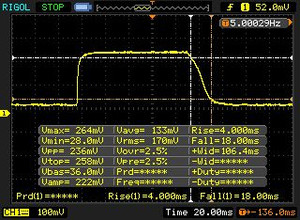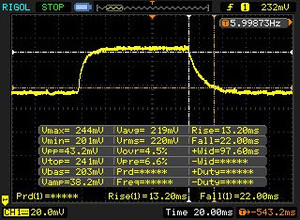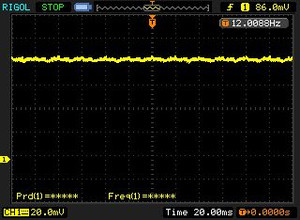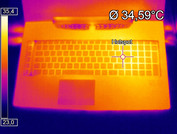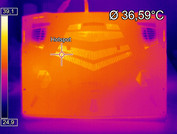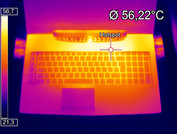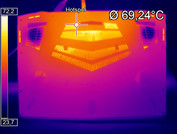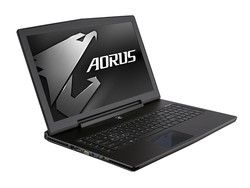Recensione breve del Portatile Aorus X7 Pro v5
| |||||||||||||||||||||||||
Distribuzione della luminosità: 91 %
Al centro con la batteria: 271 cd/m²
Contrasto: 1178:1 (Nero: 0.23 cd/m²)
ΔE ColorChecker Calman: 4.14 | ∀{0.5-29.43 Ø4.78}
ΔE Greyscale Calman: 4 | ∀{0.09-98 Ø5}
83% sRGB (Argyll 1.6.3 3D)
55% AdobeRGB 1998 (Argyll 1.6.3 3D)
61% AdobeRGB 1998 (Argyll 3D)
83.4% sRGB (Argyll 3D)
66% Display P3 (Argyll 3D)
Gamma: 2.43
CCT: 6558 K
I nostri Top 10
» Top 10 Portatili Multimedia
» Top 10 Portatili Gaming
» Top 10 Portatili Gaming Leggeri
» Top 10 Portatili da Ufficio e Business economici
» Top 10 Portatili Premium da Ufficio/Business
» Top 10 Portatili sotto i 300 Euro
» Top 10 Portatili sotto i 500 Euro
» Top 10 dei Portatili Workstation
» Top 10 Subnotebooks
» Top 10 Ultrabooks
» Top 10 Convertibili
» Top 10 Tablets
» Top 10 Tablets Windows
» Top 10 Smartphones
| Aorus X7 Pro v5 LG Philips LP173WF4-SPD1 (LGD046C) | Aorus X5 | Aorus X7 Pro AU Optronics B173HW01 V5 (AUO159D) | Eurocom X8 Chi Mei 173HGE | MSI GT80S 6QF Samsung 184HL (SDC4C48) | |
|---|---|---|---|---|---|
| Display | -1% | 5% | 4% | 4% | |
| Display P3 Coverage (%) | 66 | 61.5 -7% | 67.9 3% | 65.3 -1% | 65.5 -1% |
| sRGB Coverage (%) | 83.4 | 85.7 3% | 88.7 6% | 88.5 6% | 89.2 7% |
| AdobeRGB 1998 Coverage (%) | 61 | 61.8 1% | 64.9 6% | 64.9 6% | 65.2 7% |
| Response Times | 5% | ||||
| Response Time Grey 50% / Grey 80% * (ms) | 35 ? | 35 ? -0% | |||
| Response Time Black / White * (ms) | 22 ? | 20 ? 9% | |||
| PWM Frequency (Hz) | 250 ? | ||||
| Screen | -12% | -14% | -71% | 2% | |
| Brightness middle (cd/m²) | 271 | 324.3 20% | 318 17% | 267.9 -1% | 298 10% |
| Brightness (cd/m²) | 257 | 317 23% | 283 10% | 254 -1% | 265 3% |
| Brightness Distribution (%) | 91 | 87 -4% | 82 -10% | 78 -14% | 78 -14% |
| Black Level * (cd/m²) | 0.23 | 0.553 -140% | 0.54 -135% | 0.62 -170% | 0.35 -52% |
| Contrast (:1) | 1178 | 586 -50% | 589 -50% | 432 -63% | 851 -28% |
| Colorchecker dE 2000 * | 4.14 | 3.53 15% | 3.79 8% | 10.39 -151% | 2.72 34% |
| Colorchecker dE 2000 max. * | 8.11 | 5.4 33% | |||
| Greyscale dE 2000 * | 4 | 3.12 22% | 2.35 41% | 10.96 -174% | 3 25% |
| Gamma | 2.43 91% | 2.28 96% | 2.37 93% | 2.51 88% | 2.36 93% |
| CCT | 6558 99% | 6600 98% | 6775 96% | 13449 48% | 6995 93% |
| Color Space (Percent of AdobeRGB 1998) (%) | 55 | 55.4 1% | 58 5% | 57 4% | 58 5% |
| Color Space (Percent of sRGB) (%) | 83 | 85.2 3% | 89 7% | ||
| Media totale (Programma / Settaggio) | -7% /
-9% | -5% /
-9% | -34% /
-51% | 4% /
3% |
* ... Meglio usare valori piccoli
Tempi di risposta del Display
| ↔ Tempi di risposta dal Nero al Bianco | ||
|---|---|---|
| 22 ms ... aumenta ↗ e diminuisce ↘ combinato | ↗ 4 ms Incremento | |
| ↘ 18 ms Calo | ||
| Lo schermo mostra buoni tempi di risposta durante i nostri tests, ma potrebbe essere troppo lento per i gamers competitivi. In confronto, tutti i dispositivi di test variano da 0.1 (minimo) a 240 (massimo) ms. » 47 % di tutti i dispositivi è migliore. Questo significa che i tempi di risposta rilevati sono simili alla media di tutti i dispositivi testati (20.2 ms). | ||
| ↔ Tempo di risposta dal 50% Grigio all'80% Grigio | ||
| 35 ms ... aumenta ↗ e diminuisce ↘ combinato | ↗ 13 ms Incremento | |
| ↘ 22 ms Calo | ||
| Lo schermo mostra tempi di risposta lenti nei nostri tests e sarà insoddisfacente per i gamers. In confronto, tutti i dispositivi di test variano da 0.165 (minimo) a 636 (massimo) ms. » 47 % di tutti i dispositivi è migliore. Questo significa che i tempi di risposta rilevati sono peggiori rispetto alla media di tutti i dispositivi testati (31.6 ms). | ||
Sfarfallio dello schermo / PWM (Pulse-Width Modulation)
| flickering dello schermo / PWM non rilevato | |||
In confronto: 53 % di tutti i dispositivi testati non utilizza PWM per ridurre la luminosita' del display. Se è rilevato PWM, una media di 8108 (minimo: 5 - massimo: 343500) Hz è stata rilevata. | |||
| Cinebench R15 | |
| CPU Single 64Bit | |
| MSI GT80S 6QF | |
| Schenker XMG U716 | |
| Eurocom X8 | |
| Aorus X7 Pro v5 | |
| Alienware 17 R3 (A17-9935) | |
| Acer Predator 17 G9-791-75PV | |
| CPU Multi 64Bit | |
| MSI GT80S 6QF | |
| Schenker XMG U716 | |
| Eurocom X8 | |
| Aorus X7 Pro v5 | |
| Alienware 17 R3 (A17-9935) | |
| Acer Predator 17 G9-791-75PV | |
| Cinebench R11.5 | |
| CPU Single 64Bit | |
| MSI GT80S 6QF | |
| Schenker XMG U716 | |
| Eurocom X8 | |
| Aorus X7 Pro v5 | |
| Alienware 17 R3 (A17-9935) | |
| Acer Predator 17 G9-791-75PV | |
| CPU Multi 64Bit | |
| MSI GT80S 6QF | |
| Schenker XMG U716 | |
| Aorus X7 Pro v5 | |
| Eurocom X8 | |
| Alienware 17 R3 (A17-9935) | |
| Acer Predator 17 G9-791-75PV | |
| PCMark 7 Score | 5816 punti | |
Aiuto | ||
| PCMark 7 - Score | |
| MSI GT80S 6QF | |
| Schenker XMG U716 | |
| Eurocom X8 | |
| Acer Predator 17 G9-791-75PV | |
| Alienware 17 R3 (A17-9935) | |
| Aorus X7 Pro v5 | |
| Aorus X7 Pro v5 Samsung SM951 MZVPV512 m.2 PCI-e | Acer Predator 17 G9-791-75PV Lite-On CV1-8B256 | Alienware 17 R3 (A17-9935) Samsung PM951 NVMe 512 GB | Schenker XMG U716 Samsung SM951 MZHPV512HDGL m.2 PCI-e | Eurocom X8 Samsung SSD 840 EVO 120GB mSATA | MSI GT80S 6QF 2x Samsung SM951 MZVPV256HDGL (RAID 0) | |
|---|---|---|---|---|---|---|
| CrystalDiskMark 3.0 | -70% | -28% | -10% | -48% | 34% | |
| Read Seq (MB/s) | 1736 | 484.5 -72% | 1263 -27% | 1608 -7% | 514 -70% | 3259 88% |
| Write Seq (MB/s) | 1562 | 357.8 -77% | 587 -62% | 1577 1% | 495.4 -68% | 2556 64% |
| Read 4k (MB/s) | 51.9 | 20.8 -60% | 42.59 -18% | 44.95 -13% | 37.77 -27% | 49.38 -5% |
| Write 4k (MB/s) | 148 | 42.65 -71% | 140.6 -5% | 119.5 -19% | 111.1 -25% | 130.3 -12% |
| 3DMark 06 Standard Score | 27179 punti | |
| 3DMark Vantage P Result | 36920 punti | |
| 3DMark 11 Performance | 14777 punti | |
| 3DMark Ice Storm Standard Score | 102972 punti | |
| 3DMark Cloud Gate Standard Score | 25241 punti | |
| 3DMark Fire Strike Score | 10655 punti | |
Aiuto | ||
| 3DMark | |
| 1920x1080 Fire Strike Score | |
| MSI GT80S 6QF | |
| Eurocom X8 | |
| Schenker XMG U716 | |
| Aorus X7 Pro v5 | |
| Alienware 17 R3 (A17-9935) | |
| Acer Predator 17 G9-791-75PV | |
| 1920x1080 Fire Strike Graphics | |
| MSI GT80S 6QF | |
| Eurocom X8 | |
| Aorus X7 Pro v5 | |
| Schenker XMG U716 | |
| Alienware 17 R3 (A17-9935) | |
| Acer Predator 17 G9-791-75PV | |
| 3DMark 11 | |
| 1280x720 Performance | |
| MSI GT80S 6QF | |
| Eurocom X8 | |
| Aorus X7 Pro v5 | |
| Schenker XMG U716 | |
| Alienware 17 R3 (A17-9935) | |
| Acer Predator 17 G9-791-75PV | |
| 1280x720 Performance GPU | |
| MSI GT80S 6QF | |
| Eurocom X8 | |
| Aorus X7 Pro v5 | |
| Schenker XMG U716 | |
| Alienware 17 R3 (A17-9935) | |
| Acer Predator 17 G9-791-75PV | |
| Unigine Heaven 4.0 - Extreme Preset DX11 | |
| MSI GT80S 6QF | |
| Aorus X7 Pro v5 | |
| Schenker XMG U716 | |
| Acer Predator 17 G9-791-75PV | |
| basso | medio | alto | ultra | 4K | |
|---|---|---|---|---|---|
| Batman: Arkham Knight (2015) | 119 | 108 | 59 | 39 | 18 |
| Mad Max (2015) | 225 | 157.4 | 145.1 | 49.7 | |
| FIFA 16 (2015) | 302.4 | 247 | 173.1 | 70.8 | |
| Anno 2205 (2015) | 116.3 | 110.3 | 55.6 | 17.5 | 21.4 |
| Call of Duty: Black Ops 3 (2015) | 141.1 | 138.4 | 109.2 | 98.9 | 36 |
| Fallout 4 (2015) | 145.9 | 139.2 | 96 | 78.4 | 32.4 |
| Star Wars Battlefront (2015) | 199.8 | 196.9 | 127.1 | 109.3 | 40.8 |
| Assassin's Creed Syndicate (2015) | 83.6 | 81.4 | 76.3 | 37.6 | 30.8 |
| Rainbow Six Siege (2015) | 234.5 | 185.5 | 110.7 | 94.6 | 33.5 |
| Just Cause 3 (2015) | 127.6 | 104.5 | 60.1 | 51.7 | 21.3 |
| Rise of the Tomb Raider (2016) | 78.7 | 72.4 | 71.4 | 68 | 31.9 |
| XCOM 2 (2016) | 94.6 | 80.2 | 67.2 | 31.7 | |
| Far Cry Primal (2016) | 69 | 64 | 63 | 60 | 27 |
| The Division (2016) | 161.3 | 129.4 | 71.9 | 54.9 | 26.2 |
| Hitman 2016 (2016) | 60.7 | 60.3 | 52.2 | 50.2 | 25.1 |
| Need for Speed 2016 (2016) | 107.6 | 102.5 | 90.7 | 68.1 | 37.1 |
Rumorosità
| Idle |
| 34 / 35 / 39 dB(A) |
| Sotto carico |
| 39 / 54 dB(A) |
 | ||
30 dB silenzioso 40 dB(A) udibile 50 dB(A) rumoroso |
||
min: | ||
| Aorus X7 Pro v5 GeForce GTX 970M SLI, 6820HK | Aorus X5 GeForce GTX 965M SLI, 5700HQ | Aorus X7 Pro GeForce GTX 970M SLI, 4870HQ | Eurocom X8 GeForce GTX 980M SLI, 4940MX | MSI GT80S 6QF GeForce GTX 980 SLI (Laptop), 6820HK | |
|---|---|---|---|---|---|
| Noise | 1% | -5% | -13% | -10% | |
| off /ambiente * (dB) | 30 | ||||
| Idle Minimum * (dB) | 34 | 32.5 4% | 29.5 13% | 40.5 -19% | 34 -0% |
| Idle Average * (dB) | 35 | 32.6 7% | 32.1 8% | 41.4 -18% | 36 -3% |
| Idle Maximum * (dB) | 39 | 34.4 12% | 41 -5% | 41.6 -7% | 40 -3% |
| Load Average * (dB) | 39 | 44 -13% | 52.3 -34% | 45.6 -17% | 51 -31% |
| Load Maximum * (dB) | 54 | 56.8 -5% | 57.9 -7% | 55 -2% | 60 -11% |
* ... Meglio usare valori piccoli
(-) La temperatura massima sul lato superiore è di 55.4 °C / 132 F, rispetto alla media di 40.4 °C / 105 F, che varia da 21.2 a 68.8 °C per questa classe Gaming.
(-) Il lato inferiore si riscalda fino ad un massimo di 62.4 °C / 144 F, rispetto alla media di 43.3 °C / 110 F
(+) In idle, la temperatura media del lato superiore è di 31.8 °C / 89 F, rispetto alla media deld ispositivo di 33.9 °C / 93 F.
(-) I poggiapolsi e il touchpad possono diventare molto caldi al tatto con un massimo di 45 °C / 113 F.
(-) La temperatura media della zona del palmo della mano di dispositivi simili e'stata di 28.9 °C / 84 F (-16.1 °C / -29 F).
| Aorus X7 Pro v5 GeForce GTX 970M SLI, 6820HK | Aorus X5 GeForce GTX 965M SLI, 5700HQ | Aorus X7 Pro GeForce GTX 970M SLI, 4870HQ | Eurocom X8 GeForce GTX 980M SLI, 4940MX | MSI GT80S 6QF GeForce GTX 980 SLI (Laptop), 6820HK | |
|---|---|---|---|---|---|
| Heat | -4% | -18% | 20% | -0% | |
| Maximum Upper Side * (°C) | 55.4 | 55.6 -0% | 61.2 -10% | 44 21% | 45.7 18% |
| Maximum Bottom * (°C) | 62.4 | 57.6 8% | 59.1 5% | 41.6 33% | 61 2% |
| Idle Upper Side * (°C) | 33.6 | 36.2 -8% | 43.9 -31% | 30 11% | 36.4 -8% |
| Idle Bottom * (°C) | 34.6 | 39.4 -14% | 46.8 -35% | 29.8 14% | 39.2 -13% |
* ... Meglio usare valori piccoli
| Off / Standby | |
| Idle | |
| Sotto carico |
|
Leggenda:
min: | |
| Aorus X7 Pro v5 GeForce GTX 970M SLI, 6820HK | Aorus X5 GeForce GTX 965M SLI, 5700HQ | Aorus X7 Pro GeForce GTX 970M SLI, 4870HQ | Eurocom X8 GeForce GTX 980M SLI, 4940MX | MSI GT80S 6QF GeForce GTX 980 SLI (Laptop), 6820HK | |
|---|---|---|---|---|---|
| Power Consumption | -5% | -52% | |||
| Idle Minimum * (Watt) | 32 | 29 9% | 44 -38% | ||
| Idle Average * (Watt) | 37 | 34.8 6% | 53 -43% | ||
| Idle Maximum * (Watt) | 42 | 40.6 3% | 62 -48% | ||
| Load Average * (Watt) | 101 | 132 -31% | 163 -61% | ||
| Load Maximum * (Watt) | 245 | 276 -13% | 411 -68% |
* ... Meglio usare valori piccoli
| Aorus X7 Pro v5 94.24 Wh | Aorus X5 73 Wh | Aorus X7 Pro 73 Wh | Eurocom X8 89 Wh | MSI GT80S 6QF 75 Wh | |
|---|---|---|---|---|---|
| Autonomia della batteria | -10% | -4% | -22% | -25% | |
| Reader / Idle (h) | 3 | 2.8 -7% | 3 0% | 2.5 -17% | 2.5 -17% |
| WiFi v1.3 (h) | 2.5 | 1.9 -24% | |||
| Load (h) | 1.5 | 1.5 0% | 1.4 -7% | 1.1 -27% | 1 -33% |
| WiFi (h) | 1.5 |
Pro
Contro
Mettendo da parte l'autonomia breve e i driver GPU datati, l'Aorus X7 Pro v5 lascia una buona impressione complessiva con le performance.
Nonostante lo spessore ridotto e la seconda scheda grafica, il dispositivo non è più rumoroso o caldo della maggioranza dei rivali da 17" (sebbene ci siano problemi con il 3D).
Gigabyte deve essere lodato anche per la migliore qualità del suono, la qualità di costruzione, lo schermo con contrasto elevato e la presenza di PCIe o SSd NVMe. Nel complesso, l'utente ha dotazioni ideali per il futuro con l'X7 Pro v5. USB 3.1, G-Sync, 16 DDR4 RAM e 2x 6 GB di VRAM parlano da soli. Gli utili tools (gestione della ventola, ecc.) sono punti di forza.
Vediamo spazi di miglioramento nel touchpad, per la ricezione Wi-Fi, posizionamento della tastiera e e la distribuzione delle interfacce. Chi vuole un'esperienza di gioco senza stress (parola chiave: driver) farà meglio a cercare un portatile con una sola GPU con una GTX 980M o GTX 980.
Nota: si tratta di una recensione breve, con alcune sezioni non tradotte, per la versione integrale in inglese guardate qui.
Aorus X7 Pro v5
- 04/18/2016 v5.1 (old)
Florian Glaser




